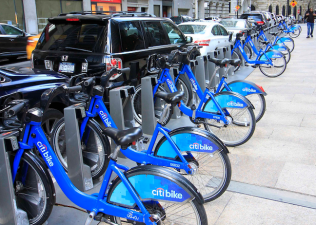America’s Biggest Bike-Share Operator Now Makes Its Own Bikes

Motivate, the company that runs bike-share systems in several large American cities, is now manufacturing its own bikes. That might explain why the timetable for Citi Bike expansion has been getting a lot firmer.
When the current Motivate management team took over last fall, they inherited two big problems. Most of their systems ran on flawed software that crippled reliability and frustrated riders, and the manufacturer of their bikes had gone bankrupt.
Now both issues have been addressed: Replacement software from 8D Technologies installed this spring has a proven track record in other cities, and the new bikes — designed by Ben Serotta — clear up how the company’s fleets will be expanded and replenished.
The new bikes will be used in the expansion of Citi Bike starting later this year, in Jersey City’s upcoming bike-share system, and in any future system operated by Motivate. Bike-share docks will be compatible with both the new bikes and the old models made by Bixi.
 The new design retains the thick boomerang-shaped frame — the notable differences are in the guts and components of the bike. Gearing has been adjusted so riders don’t spin so much in the low gear. The seats, notorious for cracking and retaining moisture in the current models, got an overhaul. “The construction and material are both supposed to improve wear,” said Serotta, “plus the hole in the middle allows water to drain and not puddle in the middle… and provides a more comfortable, better ventilated ride.” (Nigel Tufnel will be delighted to see that the seat post size now goes to 11.)
The new design retains the thick boomerang-shaped frame — the notable differences are in the guts and components of the bike. Gearing has been adjusted so riders don’t spin so much in the low gear. The seats, notorious for cracking and retaining moisture in the current models, got an overhaul. “The construction and material are both supposed to improve wear,” said Serotta, “plus the hole in the middle allows water to drain and not puddle in the middle… and provides a more comfortable, better ventilated ride.” (Nigel Tufnel will be delighted to see that the seat post size now goes to 11.)
In designing the new bikes, Serotta worked in tandem with Motivate’s head mechanics. In a short email interview, he explained that process and how it shaped the end product. Below is a lightly edited version:
What did you learn from the mechanics and how did that inform your design?
One of the first things we did when I started was talk to the lead mechanics from across all of the Motivate systems. These men and women have tens of thousands of hours of experience working on bike-share bikes.
Together we compiled historical maintenance records. We looked at the types of repairs needed, the frequency at which they occurred, how long it took an average mechanic to make that repair and how much the parts cost to fix it.
We were then able to prioritize the things that were breaking that were the most troublesome.
A few specific examples:
The headset was a major pain point. You’d expect, given the amount these bikes are being ridden, that you might need to repair the headset about once a year. These headsets needed repairs three to four times a year. We redesigned it with higher quality parts and made it easier for the mechanics to adjust it when it does need repair.
The rear hub is another example. It needed repairs way more frequently than you’d expect. So we replaced it with a Sturmey Archer hub. Sturmey Archer’s been in business for over a 100 years and are known for their quality. The gear range is improved and the internal components are stronger and should last longer.
We’ve also replaced all the bearings and cables. We wanted higher-quality bearings, stainless steel pre-stretched cables. We wanted anything that could be more corrosion-proof or durable to be more corrosion-proof and durable. When we started to talk to suppliers about this, they said, “Oh, you want Scandinavian spec.” I guess Scandinavian countries are traditionally the only ones to consistently ask for this better-quality stuff.
How do you think the new bike design will affect the customer experience?
Folks know me as the maker of high-end custom bike frames. This new project has allowed me to design a bike that’s custom-made to suit everyone.
All of the thought and planning that went into the new design will hopefully mean that the bikes spend more time on the street and less time in the shop. That means more bikes available for our customers.
Taking control of our supply chain will also be huge for both the end-user and our clients in cities across the country. Before we were at risk of being a bike-share company without bikes! Now we know, and our clients know, that we can deliver.

